The dandelion. A plant considered to be a weed by many has in recent years regained some popularity, and is slowly making a come back in the cooking scene. From making homemade dandelion syrup, wine, tea and more, dandelions provide a versatile wild food source, that anyone can take advantage of.
Originally brought to North America by the Europeans (perhaps on the Mayflower!?) for use as a medicinal herb and food source, dandelions, have since flourished and become naturalized in much of Canada, and the United States. An Important food source for bees and other pollinating insects, dandelions are one of the first flowers to make an appearance after winter and along with fiddleheads an easy to forage Spring edible . This gives us the chance to take advantage of this hardy little flower, and create some delicious food either from, or including various parts of the plant.
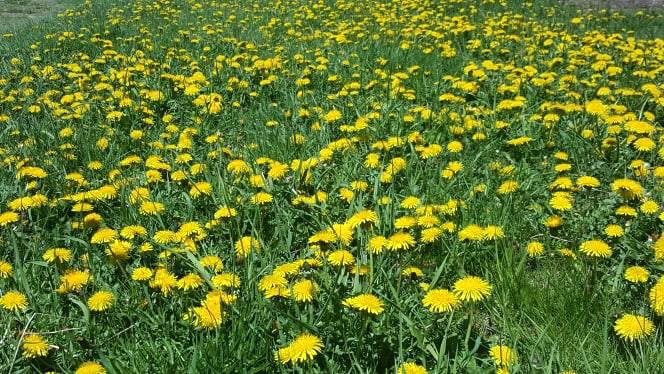
Some of the links in this post lead to affiliate sites through which Earth, Food, and Fire may earn a small commission should you make a purchase. For more info check the Affiliate Disclaimer. All advice, and opinions are based on observations from my own garden.
What Parts Of The Dandelion Can I Eat?
All parts of the dandelion are edible. The mature bright yellow flower heads make a deliciously floral syrup as well as wine, and even jelly. The dandelion syrup can be used as a substitute for maple syrup on pancakes, and waffles, it can be used to sweeten tea and coffee, and even used to bake with!
The leaves can be eaten raw or cooked and used the same way spinach and kale are used. The stem while edible, is bitter and not very palatable.
Medical & health benefits of the dandelion
The root of the dandelion can be dried and made into a delicious tea, used to treat infections, bile and liver problems, and is traditionally used as a diuretic. The green leaves are a great source of vitamins and minerals, and are particularly high in Vitamin A, C, and K. The leaves when eaten raw in salads also provide a good natural source of Calcium, Iron, and Manganese.
Making Your Own Dandelion Syrup
As dandelions are pretty comment throughout north America, it's not at all hard to find a patch of mature flowering dandelions to use in your kitchen.
If you live in an urban setting, avoid picking dandelions growing next to highways or other possible toxic locations. Exhaust and pesticides can easily contaminate the flowers, and you won't ever know! It's best to drive out into the country or find a secluded field where dandelions grow rampant. - Chef Markus Mueller
Sometimes also called dandelion honey, this recipe is not a true 'honey' and more of dandelion flavored syrup. To make this delicious golden syrup, you'll need:
- An 8L bucket filled with freshly picked dandelion flower heads
- 6 cups of sugar
- 10 liters of water
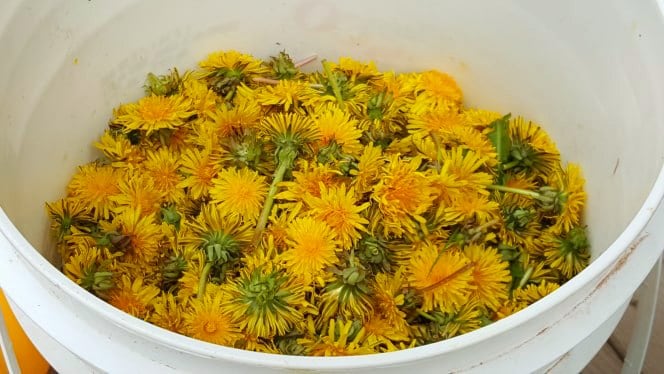
Other recipes you may find online call for 200 or so heads of dandelions, but who in their right mind is going to count them! I also found that this amount will only yield a small batch of syrup, and it's best to make a large batch to really get a return for your efforts.
And yes, picking the dandelions takes a while, so recruit, your friends, and family to help! I got my 2 year old daughter to help me and she loved playing with the flowers! It took me about an hour to pick 8 liters worth of flowers.
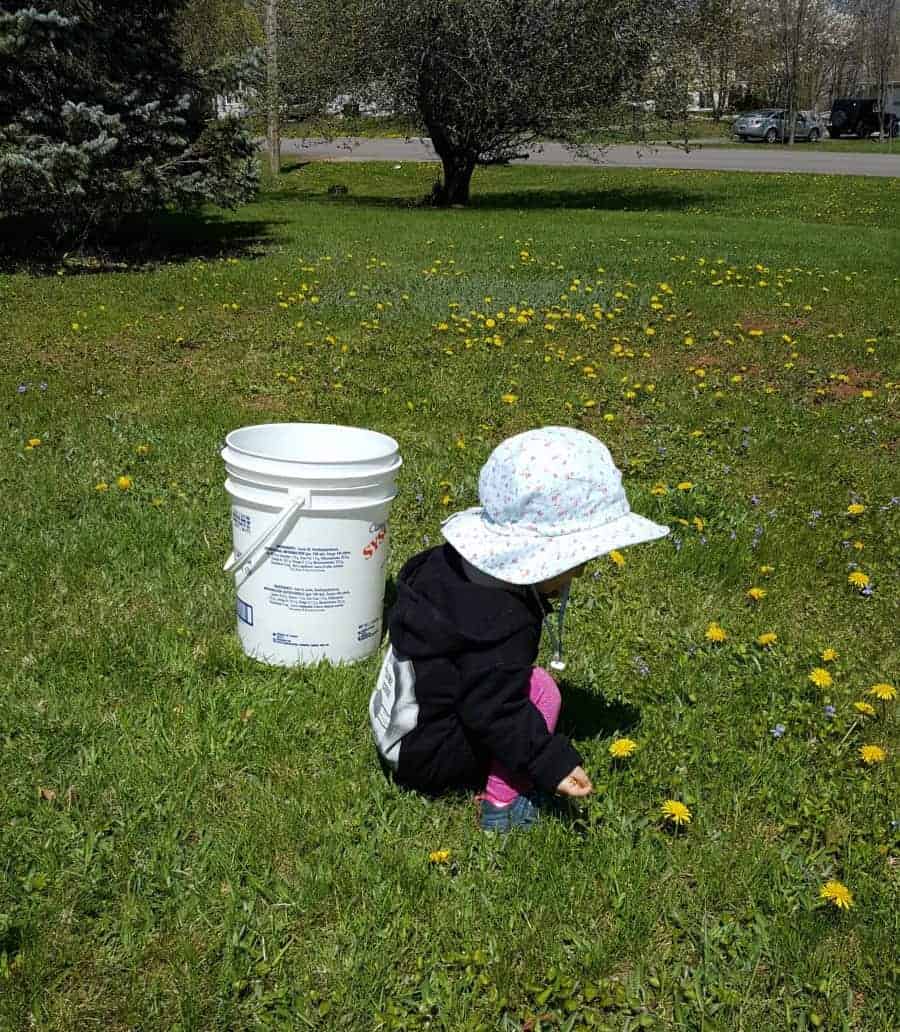
Cleaning The Flower Heads
Once the flower heads are picked, the fun really begins! As you may have noticed while foraging for the flowers, ants and other insects love the nectar and pollen these bright spring flowers hold.
This is not a bad thing though, after all we want to share this tasty plant with the other creatures around us. By trimming and cleaning the flowers you can eliminate a lot of the insects before you get cooking. I let the flower heads sit in their bucket for an hour or two, after which point the flowers will naturally start to 'close'. This makes the next step a lot easier.
To use the dandelion flowers in recipes, its important to remove the green stem and flower head base, and use just the petals. The base of the flower head contains latex, a bitter milky liquid, which is quite un-pleasent. It also stinks while cooking, and you don't want that bitterness to ruin the light floral flavor.
Simply take scissors and cut the petals of at the base. You will most likely get a little green in with it (the part that closes over the petals) but I have found this doesn't contribute much bitterness to the final product. This part is the most tedious and its best to do it with a group of people! Recruit your family to help you out!
Soaking the flower petals
Again my method here differs from other recipes in that I soak the dandelion petals in cold water for 2 days first. This helps extract some of the pollen and flavor and at the same time will send any insects scurrying.
After the flower petals have soaked, dump the whole mixture into a large pot and bring the flower petals to a boil. Simmer the dandelion petals for about 20 minutes to fully extract all the flavor. It will kind of smell like boiled spinach as the petals simmer! Periodically stir the petals to ensure they are cooking evenly and all parts get their color extracted.
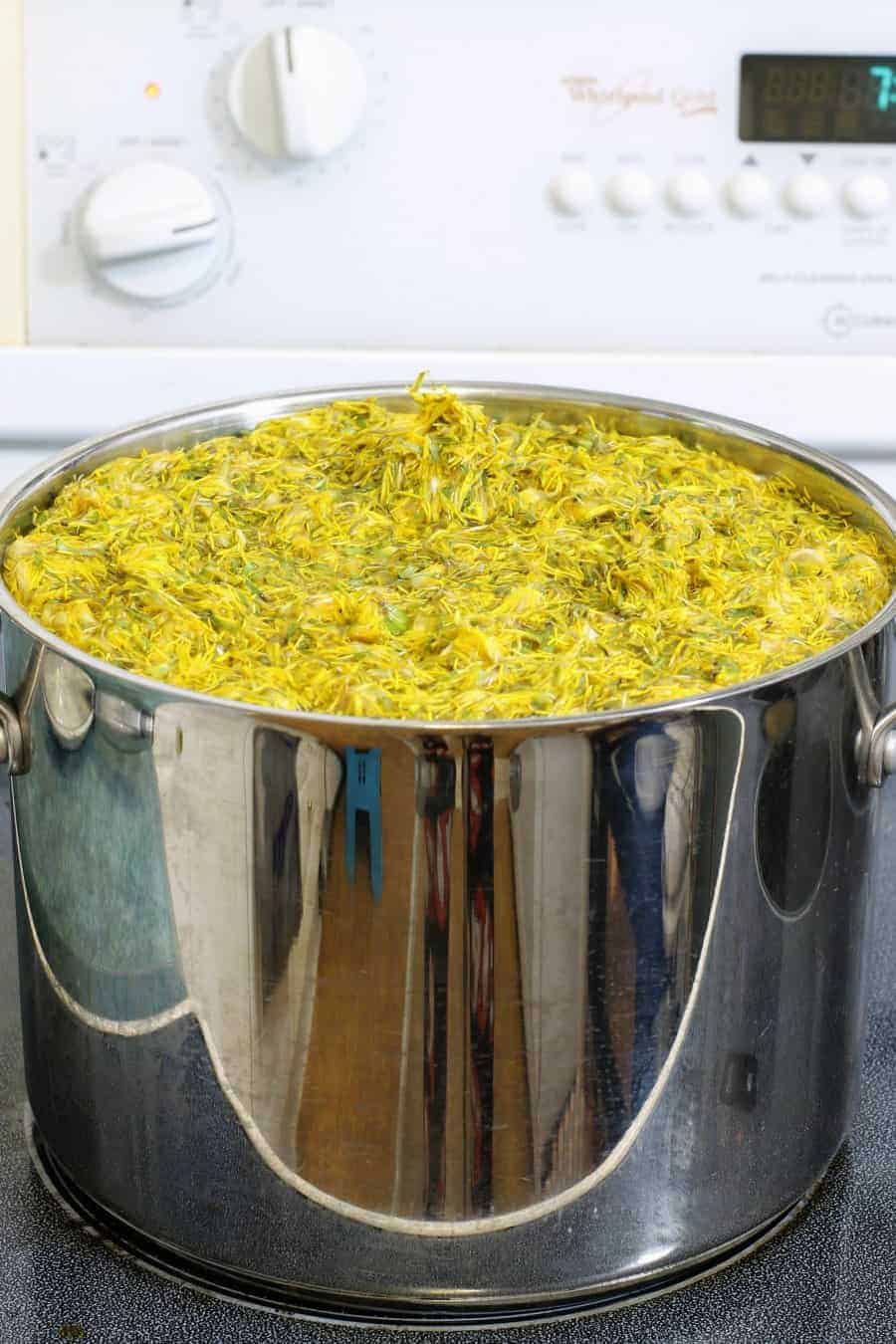
After cooking, the liquid will be a dark golden color. Strain the petals out through a fine mesh strainer or cheesecloth, to remove any sediment and plant matter. I always like to draw off a little of the liquid and check the color. It should be a nice golden yellow!

Cooking The Dandelion Extract & Sugar
Add the strained dandelion extract back to the pot, add the sugar, then bring it back to a boil.
Once the dandelion extract and sugar are boiling ,note the water level on the side of the pot (roughly). Reduce the liquid by half to thicken the syrup and intensify it's flavor. The dandelion syrup will take an hour or two to cook down over medium heat, and it's ok to let it simmer away at first. Once you notice the syrup having reduced by about half, it will start to bubble on the surface as less and less water is present, and the sugar content starts to increase.
Make sure to watch the pot at this point to avoid it from bubbling over and burning! To test the dandelion syrups consistency, spoon out a little of the syrup into a dish and cool it in the fridge to get a sense of it's true thickness.
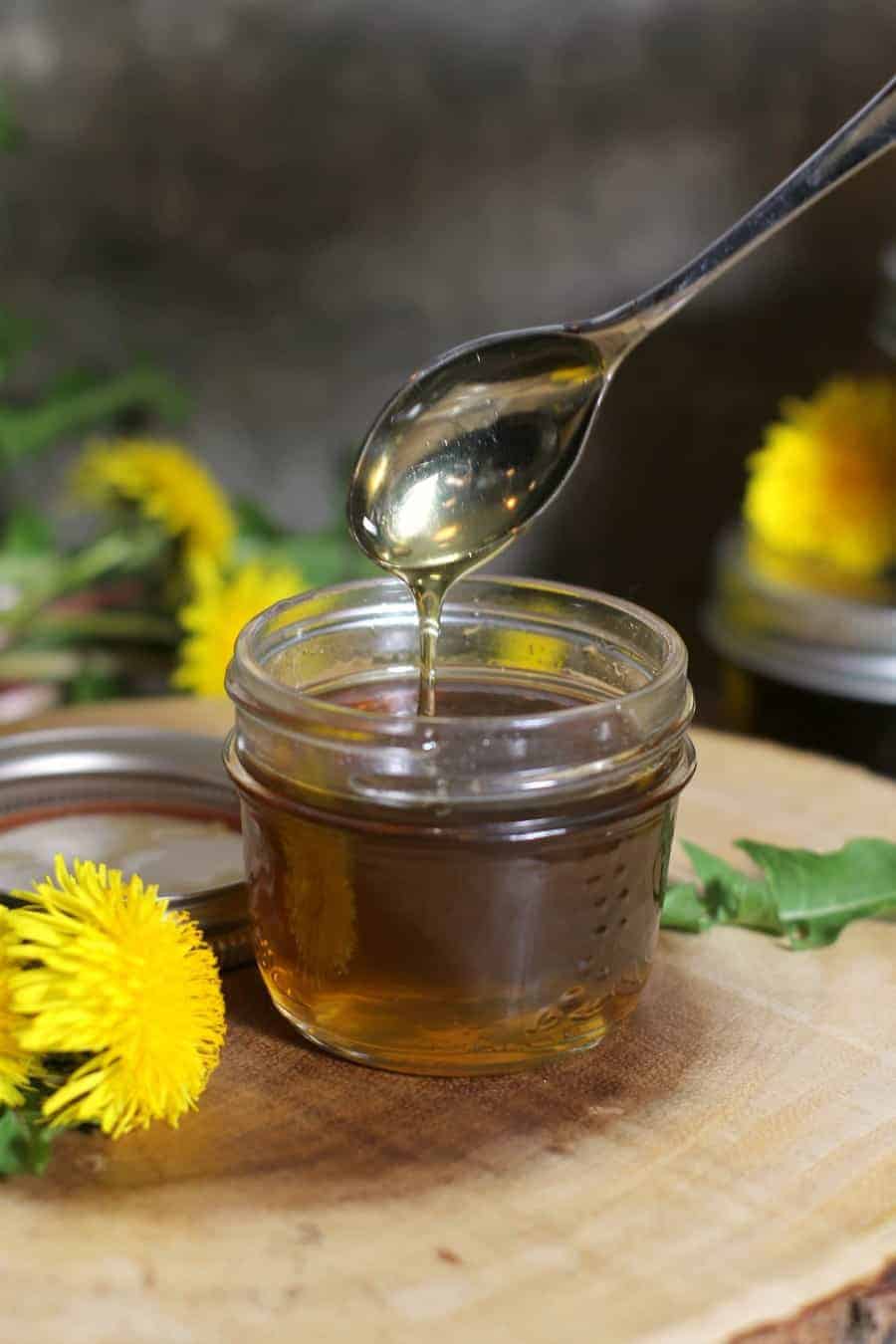
The hot the syrup will still seem quite thin. It will be very dark in color and you may think something is wrong. Hold up a glass if it to the light though, you'll be surprised by its bright golden color!!
Use a heat proof funnel to pour the hot dandelion syrup into glass bottles or jars. If you use mason jars, you can boil the lids first before sealing the hot dandelion syrup in the jars. As the jars cool, they will naturally seal and you will hear the lids 'pop' as lid seals itself.
Watch the web story: Super Easy Dandelion Syrup (Dandelion Honey)
Have you made Dandelion Syrup at home? Comment below if you have or are thinking about trying the recipe.! Take a picture and tag me on Facebook & Instagram with your results: @earthfoodandfire
Recipe
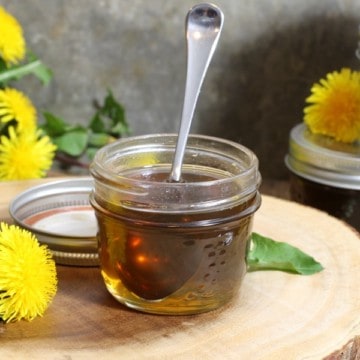
Dandelion Syrup
Ingredients
- 8 Liters freshly picked dandelion flower heads roughly
- 6 cups sugar
- 10 liters water
Instructions
- Pick fully mature dandelion flowers while in bloom. It took me about an hour to pick 8 liters worth of flowers.
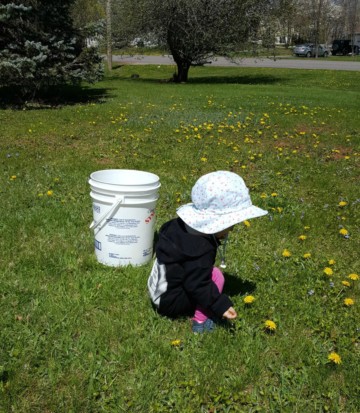
- Let the picked flower head sit in a bucket until the flowers 'close'. Take scissors and cut the petals of at the base. Discard the green plant, but save the bright yellow petals. You will most likely get a little green in with it (the part that closes over the petals) but I have found this doesn't contribute much bitterness to the final product.
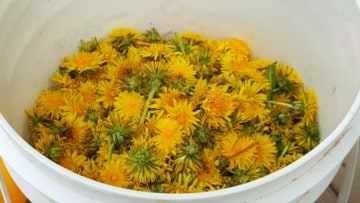
- Soak the dandelion petals in the 10 liters cold water for 2 days.
- Dump the whole mixture into a large pot and bring the flower petals to a boil. Simmer the dandelion petals for about 20 minutes to fully extract all the flavor.
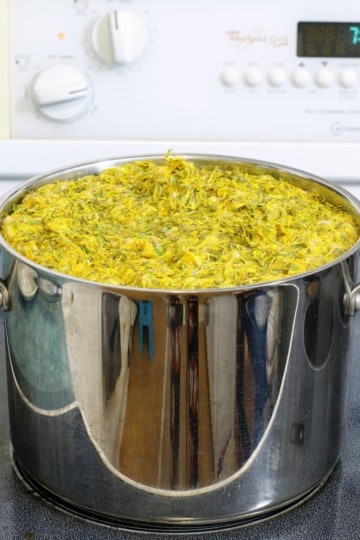
- Periodically stir the petals to ensure they are cooking evenly and all parts get their color extracted.
- Strain the petals out through a fine mesh strainer or cheesecloth, to remove any sediment and plant matter.
- Add the strained dandelion extract back to the pot, add the sugar, then bring it back to a boil.
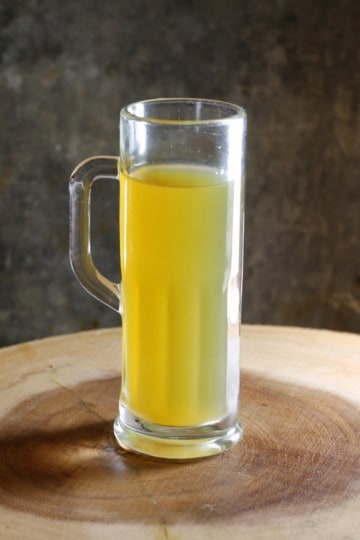
- Once the dandelion extract and sugar are boiling ,note the water level on the side of the pot (roughly). Reduce the liquid by half to thicken the syrup and intensify it's flavor.
- Once you notice the syrup having reduced by about half, it will start to bubble on the surface as less and less water is present. Watch the pot at this point to avoid it from bubbling over and burning.
- Test the dandelion syrups consistency, by spooning out a little of the syrup into a dish and cooling it in the fridge.
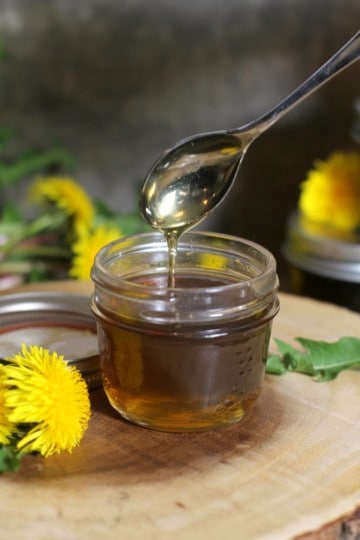
- Use a heat proof funnel to pour the hot dandelion syrup into glass bottles or jars.
Notes
Nutrition
Nutrition info is auto-generated. This information is an estimate; if you are on a special diet, please use your own calculations.

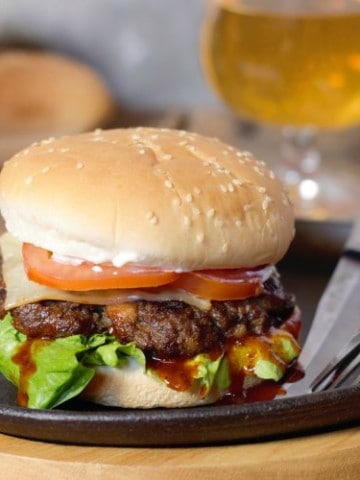
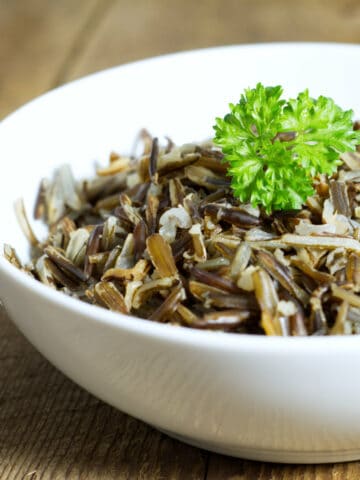
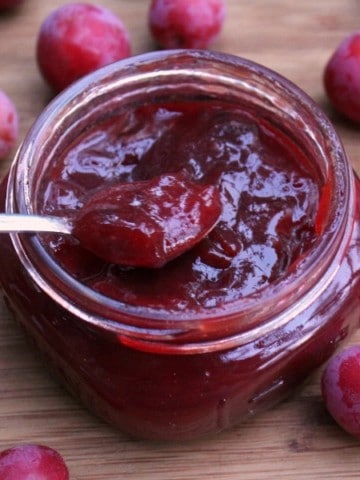
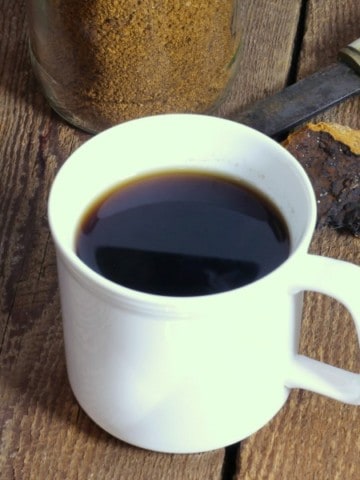
Diane Darran
Hi Chef Marcus. I am diabetic. Can I substitute something like Swerve sugar substitute for the regular honey? I've made cranberry sauce for Thanksgiving by using the Swerve, and by cooking it down I did get a syrupy sauce. Thanks for your advice in advance!
Chef Markus Mueller
Hi Diane, I have never used this sugar substitute so I can't say for sure how or if it would thicken. I would say make a small batch and see what happens!
Theresa
Yes I have made this two times now. Both came out just like syrup. The boiling takes a little over an hour before done. I added orange peel and a little lemon juice and the taste is amazing! I did can them for longer shelf life by boiler method for 12 minutes. I am trying to decide if I want to make a third batch as we have many dandelions and plenty for the bees!
Chef Markus Mueller
Hey Theresa! So glad you enjoyed the recipe! Great idea canning the jars for long term storage!
Milenia
Is this safe for toddlers? Can my 15 month old take this for cough? Do you have a recommended dose?
Thanks
Chef Markus Mueller
Hey Milenia, as with any food product containing herbal ingredients, you should always consult your family doctor or health care practitioner for advice on what is, and isn't safe for toddlers and young children. Have a great day!
Zlatka
I have made this syrup for years (came from Europe). How ever I always have the same problem, my syrup would crystalize when open. Meaning I store them in a glass jar in the fridge, no crystals, but when I open the jar I will end up having hard crystals on the bottom of the open jar. Any thoughts?
Chef Markus Mueller
Hey, you can try adding a little corn syrup to your syrup after boiling or an acid such as lemon juice, which should help prevent against crystals. The crystallization is normal due to the high sugar content of the homemade syrup, and due to the fact that it is not refined like commercially produced syrups, there is less control over the sugar content and whether or not the syrup crystalizes.
Katheryn Ponce de Leon
I live in the south and already had a yard full of dandelions. Found your recipe and picked almost all. I left some for the early honey bees. Only yielded about 2 cups after I picked off the petals by hand. Adjusted the measurements and followed the recipe. I ended up with a 6 oz ball jar of lovely syrup about honey consistency. Taste is just like their fragrance! So easy! I cant wait to have more dandelions! Can't believe I said that. Thanks!
.
Bethany Lake
Hello! I have made this once before but how long would you say it will last if I can it and seal it in my jars?
Chef Markus Mueller
Hi Bethany, I can't give you a scientific answer for that one, but if you do can the syrup, it should in theory last just as long as any other jams or syrups that are canned. I would do some of your own research into canning syrups before attempting this though. I have never canned my dandelion syrup and just make a few small batches throughout the year and store it in a cool dark place. We go through it pretty quickly so have never had to worry about canning it.
Kyana
So, I tried this, and the syrup WILL. NOT. THICKEN. We’ve even tried adding apple slices for pectin, and it still won’t work. No matter what we seem to do, it still has the same consistency as water. Any ideas?
Chef Markus Mueller
Hi Kyana, The syrup is just that a syrup. The longer you boil it the thicker it will get until eventually, all the water has evaporated and all that remains is the sugar. Keep in mind the syrup will thicken slightly as it cools and appear thing and liquidy while it is hot. That said it will not be as thick as say corn syrup. It will have a consistency similar to real maple syrup (not the thick pancake syrup you get at grocery stores).
Sid
Hi just made some this morning came out great am very please with flavor. My question is if I were to process the jars would the honey last much longer than three or four months. Last two years tried my hand at maple syrup, came out awesome. I processed jars of maple syrup and still have some that are a year old and still very good. Is it possible to do the same with the dandeline honey?
Chef Markus Mueller
Hi Sid, as long as the jars are properly processed, yes you can extend their shelf life. I like to be cautious when reccomending how long something will keep because there can be so many variables involved.
Glad you enjoyed the recipe!
Mitch Reid
hi Markus; cooking scallops, after you bread them. How long would you deep fry them?
Chef Markus Mueller
Hey Mitch, it depends on the size a bit. I would say probably 4-5 minutes. You want them to be golden brown. I would cook one until it looks done, then cut it open and see how it is!
Katherine Judkins
After steeping the dandelion flower petals my water was greenish. ? What does that mean?! Is it possible that my flowers have been exposed to pesticides?
Chef Markus Mueller
Hi Katherine, Did you trim the flower heads and use just the petals or did you also steep the green bud that is attached to the base of the head? Steeping the petals also has to be done in cold water. Once the petals have steeped for 2 days, simmer them in a pot. The liquid may look brownish-green, but cool it then hold it bit of it up to the light in a glass. It should be golden in colour. I'm not sure what effect pesticides would have on the color.
stacie chamberlin
Since this recipe doesn't call for regular canning methods, must you keep it in the fridge and how long will it keep<
Chef Markus Mueller
Hi Stacie, you can certainly heat process the dandelion syrup as you would any other preserve. Since it is just a syrup it likely won't go bad quickly if you worked with clean jars etc. That said I probably would store it in the fridge to be safe if you don't heat process the syrup. Stored in the fridge it will easily last 3-4 months.